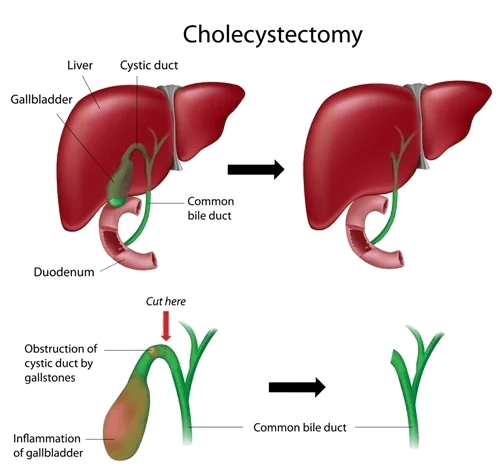Gallbladder Surgery in Phoenix
Sometimes the gallbladder can become inflamed, infected or blocked. If these ailments occur, you may either be hospitalized due to urgency, or your primary care physician may suggest cholecystectomy, or gallbladder removal surgery. Gallbladder issues are more common than you might think, but that doesn’t mean you have to put up with uncomfortable symptoms. Fortunately, at Dignity Health Medical Group, patients throughout Scottsdale, Tempe, Gilbert and the surrounding Metro area of Phoenix can receive minimally invasive gallbladder surgery from the area’s leading laparoscopic surgeon. For more information on your gallbladder surgery options, call our office in Chandler, Gilbert, or Westgate, or request an appointment online.
What is the Gallbladder?
The gallbladder is an organ that stores bile to help the body digest fat. Its main purpose is to collect and concentrate a digestive liquid (bile) produced by the liver. Bile is released from the gallbladder after eating, aiding digestion. Bile travels through narrow tubular channels (bile ducts) into the small intestine. While it performs an important function, it is not absolutely necessary. Other parts of the body can help bile reach the small intestine in the gallbladder’s absence.
What are the Symptoms of a Diseased Gallbladder?
The following symptoms could be an indication of an inflamed or infected gallbladder:
- Pain in the upper abdomen
- Tenderness in the abdomen
- Pain in the abdomen after meals
- Nausea
- Vomiting
- Fever
- Chronic Diarrhea
- Jaundice: A sign of a common bile duct block or stone.
- Light Colored Stools or Dark Urine
These symptoms may be more pronounced after eating a high-fat or large meal.
Learn about Single-Site™ da Vinci® Surgery (Gallbladder Surgery)
What happens when a Gallbladder is diseased?
Though it may depend on the disease, most solutions to gallbladder disease treatment involve surgical removal of the gallbladder. Problems that arise from the gallbladder are usually the result of gallstones. Common types of gallbladder diseases are:
- Cholecystitis: This is the inflammation of the gallbladder.
- Gallstones: Much like kidney stones, a hardened deposit may form in the gallbladder, which can cause pain because of inflammation.
- Gallbladder Polyps: Non-cancerous tumors or growths may form in the gallbladder. Depending on the severity, this may need to be surgically removed.
- Gallbladder Cancer: Though very rare, gallbladder cancer still happens, and isn’t commonly detected due to infrequent testing.

How is Gallbladder Surgery Performed?
Gallbladder removal is one of the most commonly performed surgical procedures in the United States. Today, gallbladder surgery is performed laparoscopically at one of our Phoenix area hospitals. The medical name for this procedure is Laparoscopic Cholecystectomy. During minimally invasive gallbladder surgery, your general surgeon removes the gallbladder with precision instruments through either a small incision in the belly button or a few small incisions. One of the instruments used has a small camera attached to it, which allows the surgeon to take pictures inside the body to guide the operation. The camera also relays the image inside to a TV screen outside, and the surgeon uses the other instruments to separate the gallbladder and remove it from under the liver.
Patients are usually able to return home the day of the surgery, and because the procedure requires minimal downtime, there can be a return to normal activities much quicker than with “traditional” open surgery. Laparoscopic gallbladder removal has been shown to be a safe and effective treatment for gallbladder problems.
What can I expect after Gallbladder Removal?
For the first few weeks, it is recommended that patients limit their intake to foods low in fat. A normal diet may be resumed after this period has passed. Most patients only notice minimal changes to their digestion, if any at all. But, in rare instances, digestive discomfort may be felt. Most patients can return to work within seven days following the laparoscopic procedure depending on the nature of your job. Phoenix patients with administrative or desk jobs usually return in a few days while those involved in manual labor or heavy lifting may require a bit more time. However, patients that undergo an open procedure usually resume normal activities in four to six weeks.
Benefits of a da Vinci Cholecystectomy
There are many benefits to da Vinci gallbladder surgery, including:
- Low rate of complications
- Minimal, if any, scarring from the surgery
- Minimal pain
- Shorter hospital stay
- Low rate of wound infection
What are the Risks of Gallbladder Surgery?
Every surgery comes with risk. If you are undergoing a minimally invasive Cholecystectomy, there are a few risks to keep in mind, such as:
- Potential injury to small and large intestine
- Urinary retention
- A hernia at the incision site
- Potential bile duct injury
Consult one of our physicians if you believe you may be a candidate for a da Vinci Cholecystectomy procedure.
Contact Us for Your Gallbladder Removal in Phoenix
Contact Dignity Health Medical Group for any additional questions you have regarding gallbladder removal. With our offices in Chandler, Westgate and Gilbert, we are conveniently located to patients throughout the Phoenix area including Mesa, Scottsdale, and Tempe.